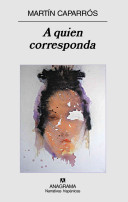 W
WA quien corresponda is an Argentine novel by Martín Caparrós. It was first published in 2008. The book is a combination of anecdotes, stories, and situations recalled by the protagonist, Carlos "el Gallego"(the Galician), in order to remember his partner, who was assassinated by the Argentinian military during the National Reorganization Process.
 W
WA veinte años, Luz is the first novel by Argentinian author Elsa Osorio, first published in 1998. The English-language version of her novel, My Name is Light, was first published in 2003.
 W
WAbaddón, el exterminador is the last novel by Argentine author Ernesto Sabato. It was first published in 1974, and forms the culmination of his work, the third in the loosely related trilogy begun with The Tunnel and followed with On Heroes and Tombs.
 W
WThe Abencerraje, also known as The History of the Abencerraje and the Lovely Jarifa, is a 'Moorish novel' written in Spain in the sixteenth century. Although it was published anonymously, some scholars believe that its author was Jerónimo Jiménez de Urrea. Various versions were published between 1561 and 1565. However, the most polished and complete is considered to be that included in the Inventario, a compilation by Antonio de Villegas printed in Medina del Campo in 1565. The novel takes place in the 15th century, when Castile and the Emirate of Granada were competing for supremacy over southern Spain. It shows how its characters, the Moor Abindarráez and the Christian Rodrigo de Narváez, can live in harmony despite their religious differences. It explores themes such as love and chivalry.
 W
WAdam Buenosayres is a 1948 novel by the Argentine writer Leopoldo Marechal. The story takes place in Buenos Aires in the 1920s, and follows a vanguard writer who goes through a metaphysical struggle during three days. The book is a humorous account of the Martinfierristas movement, which was prominent in Argentine literature in the 1920s.
 W
WAfter the Winter is a novel by Mexican writer Guadalupe Nettel, published in 2014 by the publishing house Editorial Anagrama and winner of the prestigious Premio Herralde in its edition of the same year. The story follows Claudio, a Cuban misanthrope who lives in New York City, and Cecilia, a lonely Mexican who is doing her postgraduate studies in Paris, whose lives eventually become intertwined in a brief affair.
 W
WAmong the Lost is a 2015 novel by Mexican author Emiliano Monge.
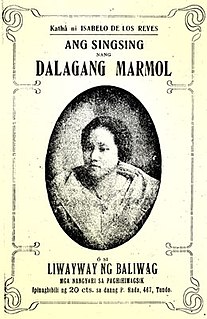 W
WAng Singsing nang Dalagang Marmol, contemporarily rendered as Ang Singsing ng Dalagang Marmol in the Tagalog language, is a historical novel written by Filipino novelist, scholar, and labor leader Isabelo Florentino de los Reyes before 1905. It is one of the first historical novels written in the Philippines during the first decade of the 20th century. It was also one of the first novels during the period that was written using the technique of blending fact and fiction. Through the novel, De los Reyes revealed his knowledge of the actual events during the Philippine–American War, making the subject as "integral elements" of the book. Based on the original 1912 bookcover for the novel, Ang Singsing ng Dalagang Marmol is alternatively titled Si Liwayway ng Baliwag.
 W
WThe Angel's Game is a prequel to 2001's The Shadow of the Wind, by Spanish author Carlos Ruiz Zafón. The novel marks a return to The Cemetery of Forgotten Books in Barcelona's Raval district, and the Sempere & Sons bookshop. Like The Shadow of the Wind, it was translated into English by Lucia Graves and published in 2009.
 W
WAura is a short novel written by Mexican novelist Carlos Fuentes, first published in 1962 in Mexico. This novel is considered as a fantastic literature for its remarkable description of “dreamlike” themes and the complexion of “double identity” portrayed by the character. Its narrative is completely carried out in second person. The first English translation, by Lysander Kemp, was published in 1965 by Farrar, Straus and Giroux. It was adapted to the screen in 1966 in La strega in amore, starring Richard Johnson, Rosanna Schiaffino and Gian Maria Volonté.
 W
WLa Bastarda is a novel by Trifonia Melibea Obono originally published in Spanish in 2016. The book is banned in Equatorial Guinea. The book tells the story of Okomo, an orphan who was born a bastard whose mother died during childbirth, and lives in a traditional village in Equatorial Guinea that is about a day's walk from Gabon. She is forced to confront her cultures attitudes about gender roles, requirements for women to have sex for the purpose of reproduction at the direction of men, and sexuality. After being outed, she eventually retreats to the sanctuary of the freedom of the forest.
 W
WBlanca Olmedo is perhaps the best known novel of the noted Honduran novelist Lucila Gamero. A romance novel, published at a time when the trend for romantic literature had fallen out of fashion in Central America, it was completed in 1903 and published in 1908. It is considered to be one of the most important novels in Honduran literature in the early twentieth century. It is unusual given that it was written by a female writer who was critical of the corrupt establishment in Honduras.
 W
WBy Night in Chile is a novella written by Chilean author Roberto Bolaño, and first published in 2000. It was the first of Bolaño's novels to be published in English, with Chris Andrews's English translation, which appeared in 2003 under New Directions.
 W
WCartagena is a 2015 Spanish-language novel by Uruguayan writer Claudia Amengual.
 W
WChristopher Unborn is the tenth novel by the Mexican author Carlos Fuentes. Originally published by the Fondo de Cultura Económica in 1987, the first U.S. edition was published in 1989 by Farrar, Straus & Giroux.
 W
WCount Julian is a 1970 novel by the Spanish writer Juan Goytisolo. The title refers to Julian, count of Ceuta. The book was published in Mexico by Editorial Joaquín Mortiz. It is the second installment in the Álvaro Mendiola trilogy, which also includes Marks of Identity and Juan the Landless.
 W
WThe Crystal Frontier is a 1995 novel written by Mexican writer Carlos Fuentes. The title can also be translated as "The Glass Border". An English translation was published in 1997.
 W
WCumandá o Un drama entre salvajes is a classic Ecuadorian novel by Juan León Mera. The novel was written in 1877.
 W
WDaughter of Fortune is a novel by Isabel Allende, and was chosen as an Oprah's Book Club selection in February 2000. It was published first in Spanish by Plaza & Janés in 1998. Isabel Allende says "of her female protagonist in Daughter of Fortune, Eliza, that she might well represent who the author might have been in another life." "Allende spent seven years of research on this, her fifth novel, which she says is a story of a young woman's search for self-knowledge." "Allende also believes that the novel reflects her own struggle to define the role of feminism in her life." Allende also wrote a sequel to Daughter of Fortune entitled Portrait in Sepia which follows Eliza Sommers' granddaughter.
 W
WThe Death of Jesus is a 2019 novel by Nobel Prize-winning writer J.M. Coetzee; it is the third in his "Jesus" trilogy, following The Childhood of Jesus (2013) and The Schooldays of Jesus (2016). It was first published in Spanish under the title La muerte de Jesús and distributed throughout Latin America. In fact, it is the second of Coetzee's books to appear first in Spanish, the first being Siete cuentos morales or "Moral Tales".
 W
WClaudia Amengual Puceiro is a Uruguayan writer and translator. She is a recipient of the Sor Juana Inés de la Cruz Prize.
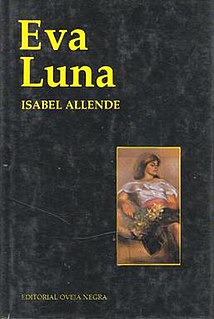 W
WEva Luna is a novel written by Chilean novelist Isabel Allende in 1987 and translated from Spanish to English by Margaret Sayers Peden.
 W
WExiled from Almost Everywhere is a 2008 novel by the Spanish writer Juan Goytisolo. It tells the story of a Parisian pervert who ends up in an electronic afterlife where invisible souls communicate with e-mails.
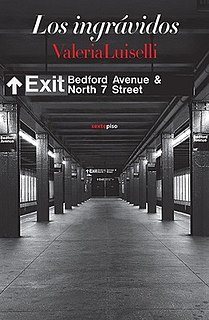 W
WFaces in the Crowd is a novel by the Mexican author Valeria Luiselli in 2011. Christina MacSweeney's English translation was published by Coffee House Press in 2014.
 W
WFiesta al noroeste is a novel written by Ana Maria Matute and first published in 1952.
 W
WEl filibusterismo, also known by its alternative English title The Reign of Greed, is the second novel written by Philippine national hero José Rizal. It is the sequel to Noli Me Tángere and, like the first book, was written in Spanish. It was first published in 1891 in Ghent.
 W
WThe General in His Labyrinth is a 1989 dictator novel by Colombian writer and Nobel laureate Gabriel García Márquez. It is a fictionalized account of the last seven months of Simón Bolívar, liberator and leader of Gran Colombia. The book traces Bolívar's final journey from Bogotá to the Caribbean coastline of Colombia in his attempt to leave South America for exile in Europe. Breaking with the traditional heroic portrayal of Bolívar El Libertador, García Márquez depicts a pathetic protagonist, a prematurely aged man who is physically ill and mentally exhausted. The story explores the labyrinth of Bolívar's life through the narrative of his memories, in which "despair, sickness, and death inevitably win out over love, health, and life".
 W
WHijo de ladrón is a Chilean novel, written by Manuel Rojas. It was first published in 1951.
 W
WHistorias de un arrabal parisino is the third novel by the Venezuelan Vicente Ulive-Schnell and was published by Ediciones Idea in Spain. The semi-biographical book is based on two articles that appeared in both the online and print editions of the New York newspaper El Nuevo Cojo Ilustrado in 2004. The novel recounts the adventures of a young Venezuelan student in Paris, and his travels through the city's most distressed neighborhoods, Barbès and Château-Rouge.
 W
WThe House of the Spirits is the debut novel of Isabel Allende. The novel was rejected by several Spanish-language publishers before being published in Buenos Aires in 1982. It became an instant best-seller, was critically acclaimed, and catapulted Allende to literary stardom. The novel was named Best Novel of the Year in Chile in 1982, and Allende received the country's Panorama Literario award. The House of the Spirits has been translated into over 20 languages.
 W
WHurricane Season is the second novel by Mexican writer Fernanda Melchor, published in April 2017 by Literatura Random House. It is a nonlinear narrative and a third-person narrative. It focuses on the events surrounding the murder of the Witch of La Matosa, an impoverished fictional town in Mexico through which Melchor explores violence and machismo in Mexican society.
 W
WI, the Supreme is a historical novel written by exiled Paraguayan author Augusto Roa Bastos. It is a fictionalized account of the nineteenth-century Paraguayan dictator José Gaspar Rodríguez de Francia, who was also known as "Dr. Francia." The book's title derives from the fact that Francia referred to himself as "El Supremo" or "the Supreme." The first in a long line of dictators, the Supreme was a severe, calculating despot. The central themes of the novel are power and language and the relation between the two. The Supreme believes himself to be above all power and history: "I don't write history. I make it. I can remake it as I please, adjusting, stressing, enriching its meaning and truth." Yet this assertion is constantly challenged by the very fact that while he achieves power by means of writing and dictating, these very same methods can be used by others to dispute his authority. Not even his own identity, represented by the personal pronoun I, is safe and can easily be usurped as is demonstrated by the incident of the pasquinade. Language, as powerful as it is, can never be controlled and can just as easily be used as an instrument of coercion as an instrument of resistance.
 W
WInez is a 2001 novel by the Mexican writer Carlos Fuentes.
 W
WEl Jetón is the final novel published by Salvadoran writer Arturo Ambrogi shortly before his death in 1936. It is considered a classic in Salvadoran literature.
 W
WJuan the Landless is a 1975 novel by the Spanish writer Juan Goytisolo. Published by Seix Barral, it marked Goytisolo's return to a Spanish publisher following the death of Francisco Franco. It is the last installment in the Álvaro Mendiola trilogy, which also includes Marks of Identity and Count Julian.
 W
WThe Labyrinth of the Spirits is a fiction novel by Spanish author Carlos Ruiz Zafón. This is the fourth and final book in the Cemetery of Forgotten Books series. The novel was initially released on 17 November 2016 in Spain and Latin America by Planeta Group. HarperCollins published the English translation by Lucia Graves on September 18, 2018.
 W
WLove in the Time of Cholera is a novel by Colombian Nobel prize winning author Gabriel García Márquez. The novel was first published in Spanish in 1985. Alfred A. Knopf published an English translation in 1988.
 W
WMala onda is a Chilean Bildungsroman novel and social commentary by Alberto Fuguet. It is also Fuguet's debut novel, first published in 1991.
 W
WMarks of Identity is a 1966 novel by the Spanish writer Juan Goytisolo. It was published in Mexico through Editorial Joaquín Mortiz. It is the first installment in the Álvaro Mendiola trilogy, which also includes Count Julian and Juan the Landless.
 W
WMen of Maize is a 1949 novel by Guatemalan Nobel Prize in Literature winner Miguel Ángel Asturias. The novel is usually considered to be Asturias's masterpiece, yet remains one of the least understood novels produced by Asturias. The title Hombres de maíz refers to the Mayan Peoples' belief that their flesh was made of corn. Its title originates in the Popol Vuh, one of the sacred books of the Maya. The English translation is part of the UNESCO Collection of Representative Works.
Nínay is a novel in the Spanish language written by Pedro Alejandro Paterno, and is the first novel authored by a native Filipino. Paterno authored this novel when he was twenty-three years old and while living in Spain in 1885, the novel was later translated into English in 1907 and into Tagalog in 1908. According to Dominador D. Buhain in his book A History of Publishing in the Philippines, being the first Filipino novel, Ninay marked the beginning of the awakening of national consciousness among the Filipino intelligentsia. Being a "largely cultural" novel, the narrative provides a "folkloristic tour" of the distinctive culture of the Philippines. Composed of 262 pages, the 1908 Tagalog version of the novel was published by the Limbagan Nang La Republika Kiotan Bilang 30 during the American period in Philippine history.
 W
WNoli Me Tángere is an 1887 novel by José Rizal during the colonization of the Philippines by the Spanish Empire, to describe perceived inequities of the Spanish Catholic friars and the ruling government.
 W
WRespiración artificial is an Argentine novel, written by Ricardo Piglia. It was first published in 1980. Praised by critics, the work has been the subject of several studies. The epigraph which opens the novel is a quote by T.S Eliot and the key to understanding the novel. The back cover of the book reads: “Conceived as a system of quotes, cultural references, allusions, plagiarisms, parodies and pastiches, Piglia's novel is not only the realization of Walter Benjamin's old dream ; it is as well a modern and subtle detective novel″.
 W
WSanta Evita is a 1995 novel by the Argentine writer Tomás Eloy Martínez. In a blend of fact and fiction, the novel focuses on the Argentine first lady Eva Perón, and tracks her embalmed corpse after her death from cancer at age 33. The book became a bestseller in Argentina and has been widely translated. Worldwide, it estimated to have sold 10 million copies, which makes it one of the best-selling books of all time.
 W
WEl Señor Presidente is a 1946 novel written in Spanish by Nobel Prize-winning Guatemalan writer and diplomat Miguel Ángel Asturias (1899–1974). A landmark text in Latin American literature, El Señor Presidente explores the nature of political dictatorship and its effects on society. Asturias makes early use of a literary technique now known as magic realism. One of the most notable works of the dictator novel genre, El Señor Presidente developed from an earlier Asturias short story, written to protest social injustice in the aftermath of a devastating earthquake in the author's home town.
 W
WSenselessness is the English translation of the 2004 novel Insensatez, originally written in Spanish by Salvadoran writer Horacio Castellanos Moya. Senselessness was translated by Katherine Silver and published in 2008 by New Directions Publishers. The translation was short-listed for the 2009 Best Translated Book Award.
 W
WThe Shadow of the Wind is a 2001 novel by the Spanish writer Carlos Ruiz Zafón and a worldwide bestseller. The book was translated into English in 2004 by Lucia Graves and sold over a million copies in the UK after already achieving success on mainland Europe, topping the Spanish bestseller lists for weeks. It was published in the United States by Penguin Books and in Great Britain by Weidenfeld & Nicolson and Orion Books. It is believed to have sold 15 million copies worldwide, making it one of the best-selling books of all time.
 W
WLa sombra de Heidegger is a 2005 thriller written by the Argentine philosopher and novelist José Pablo Feinmann. It depicts an exiled Nazi professor called Dieter Müller who writes a letter to his son, in which he describes the philosophy of Martin Heidegger as the spiritual guidance of the Nazi Party. Besides, La sombra de Heidegger has some elements that would enable it to be included in the category of historical novel. Although there are fictional characters, most of the people involved in the novel are public—and often controversial—figures, such as Adolf Hitler, Ernst Röhm, Jean-Paul Sartre and so on.The novel also covers topics of Argentine political life. More than once Müller satirizes the situation of peronism in Argentina.
 W
WSpace Invaders by Nona Fernández was originally published in Spanish in 2013, and translated into English in 2019. This story follows the jumbled memories, letters, and dreams of some of the classmates of Estrella González, a young woman who mysteriously disappeared under the Pinochet military regime in Chile. The story is structured around and includes many aspects of its namesake - the 1978 video game Space Invaders.
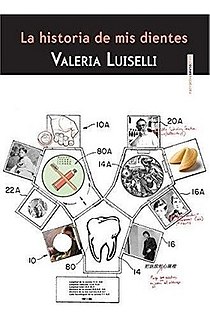 W
WThe Story of My Teeth (La historia de mis dientes) is a 2013 Spanish-language novel by Valeria Luiselli, translated into English in 2015 by Christina MacSweeney. The novel tells the story of Gustavo "Highway" Sánchez Sánchez, an auctioneer in Mexico City who auctions off various historical and literary figures' teeth. Originally commissioned as an exhibition catalog for Galería Jumex, the novel was written in collaboration with workers at a Jumex factory in Ecatepec. Luiselli would submit chapters for lectores to read to the factory workers, who would then send recordings of their discussions back to Luiselli. The English-language edition also features a chapter written by Luiselli's translator MacSweeney. The novel was a finalist for the 2015 National Book Critics Circle Award in fiction.
 W
WTerra Nostra is a 1975 novel by the Mexican writer Carlos Fuentes. The narrative covers 20 centuries of European and American culture, and prominently features the construction of El Escorial by Philip II. The title is Latin for "Our earth". The novel received the Xavier Villaurrutia Award in 1976 and the Rómulo Gallegos Prize in 1977.
 W
WTres tristes tigres, abbreviated as TTT, is the debut novel by Cuban writer Guillermo Cabrera Infante. The novel was first published in Spain in 1967. It was later translated into English by Donald Gardner and Suzanne Jill Levine and published in 1971 as Three Trapped Tigers.
 W
WVictus, the fall of Barcelona, is a historical novel by the Catalan anthropologist Albert Sánchez Piñol published by HarperCollins in September 2014. It is based in the fictitious biography of the Lieutenant Colonel Marti Zuviria who, being 98, tells from Vienna his memories as an engineer serving the commander Antoni de Villarroel during the War of the Spanish Succession, especially during the Siege of Barcelona.
 W
WWe Are Not From Here is a young adult novel by Jenny Torres Sanchez, published May 19, 2020 by Philomel Books.
 W
WYo-Yo Boing! (1998) is a postmodern novel in English, Spanish, and Spanglish by Puerto Rican author Giannina Braschi. The cross-genre work is a structural hybrid of poetry, political philosophy, musical, manifesto, treatise, memoir, and drama. The work addresses tensions between Anglo-American and Hispanic-American cultures in the United States.
 W
WZama is a 1956 novel by Argentine writer Antonio di Benedetto. Existential in nature, the plot centers around the eponymous Don Diego de Zama, a minor official of the colonial Spanish Empire stationed in remote Paraguay during the late 18th century and his attempts to receive a long-awaited promotion and transfer to Buenos Aires in the face of personal and professional stagnation. Di Benedetto drew heavily from Russian writer Fyodor Dostoevsky. These existential themes of inward and outward stasis because of circumstance drive the novel's narrative as being constantly in motion yet never changing. Together with two of his other novels, El silenciero (1964) and Los suicidas (1969), Zama has been published as part of Benedetto's informal La trilogía de la espera. The novel is considered by various critics to be a major work of Argentine literature.